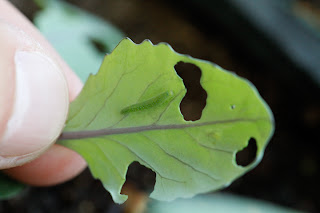When you see what can happen to a flat of unprotected cole crops in a matter of just days if you're not paying attention, it's not an exaggeration to call these small, pale yellow-green butterflies killers. They, or rather their well-camouflaged offspring, can decimate a flat of seedlings if you don't take quick action to stop them.
 |
| Denuded cabbage & broccoli seedlings |
The first thing to look for is cabbage butterflies flying around your yard. These are the same little butterflies that get stuck to your windshield and grill in droves if you drive up County Road 102 towards Woodland in the middle of August. These buggers move so quickly, you can hardly catch them sitting still. I honestly don't know how they manage to deposit so many caterpillar eggs on the leaves when they never stop flitting about. Here's an action shot of one visiting my broccoli bed:
If you see the butterflies in your garden, start checking the underside of the leaves of your cole crop seedlings for teeny tiny yellowish egg sacks that stick straight off the surface of the leaf, as in the photo below. (In my experience, they don't go after other types of plants.) Those eggs will quickly hatch into teeny tiny caterpillars that are the exact same color of the leaf and therefore hard to locate once they appear and start chowing down on your plants.
 |
| Cabbage butterfly eggs on a broccoli leaf |
The eggs are easily removed with a gentle swipe of your finger, but be careful you don't tear the leaf apart as you're scraping off the eggs. Seedlings are tender and easily damaged by gloved hands. If you're diligent about monitoring your seedlings for eggs, you can avoid any damage to the plants in the first place by ridding them of caterpillars before they hatch.
You're bound to miss a few, though, and sometimes there isn't time for individual preventive attention to each seedling. In that case, monitor carefully for holes in the leaves and take action the minute you see them. If there's a little hole, there's a little caterpillar, and both will only get bigger if you do nothing!
 |
| Cabbage butterfly worm |
 |
| Look who's poking his head out through the hole in the leaf! |
When I find worms, I like to pick them off the plants by hand and feed them to the chickens (my chickens are goofy and get intimidated by big caterpillars, so they're happy with these mini ones). An alternative would be to buy some Bt (Bacillus thuringiensis), a natural caterpillar-destroying bacteria, but in my experience it's not very effective in a small garden.
That's because when you only have one or two beds of cabbage plants, it takes just as much time to apply Bt as it does to watch for eggs and pick them off. The caterpillars have to ingest the Bt, for one thing, so they may munch a while longer before they die. Because they have to eat Bt, you have to spray it on both the top and underside of every leaf, which can be awkward and time-consuming. Finally, Bt breaks down after about a week, so you have to spray regularly if you want long-term control.
Other options would be to cover the plants with floating row cover (even that is a little heavy for one-week-old seedlings) or another screening material. I've protected seedlings by covering them with an upturned homemade soil sifter.
 |
| Soil sifter re-purposed as cabbage butterfly protection |
Next season I hope to have more permanent solutions in place for both seedlings in planting trays and starts in the garden beds. I plan to make simple screened boxes that fit over my seed starting trays, and larger ones that use floating row cover on a basic frame made with leftover 1 x 2s. Because my garden beds are uniformly sized, one contraption will fit all of them and can be rotated as needed throughout the garden. For now, a hodge podge of solutions will have to do, plus vigilance in removing those eggs. It will all be worthwhile four months from now when I'm pulling beautiful heads of cabbage and broccoli from the garden!

I will buy my cabbage (or eat yours) since I have little patience for those little guys. Swiss chard and kale, however, did well last year. Minimal pests.
ReplyDeleteLet's trade cabbage for Swiss chard! My chard got attacked by little black aphids last year.
DeleteThanks for sharing such beautiful information with us. I hope you will share some more information about broccoli and cauliflower. Please keep sharing.
ReplyDeleteHealth Is A Life